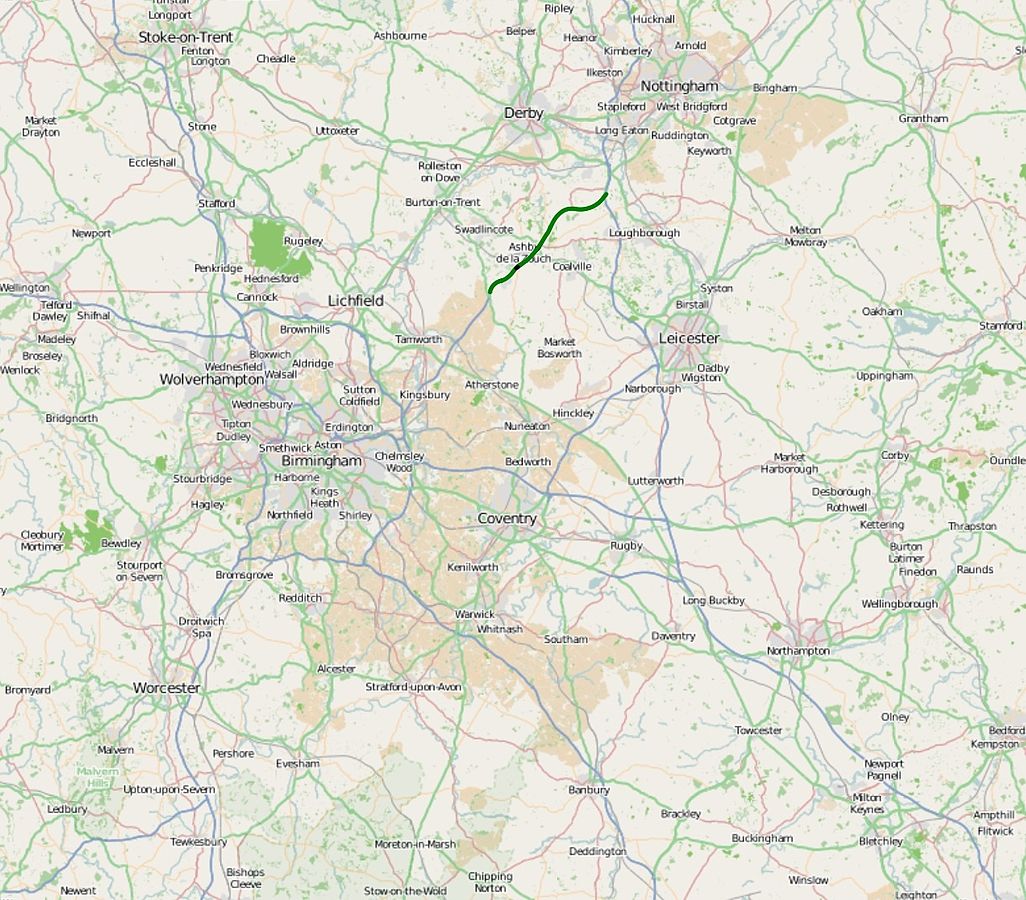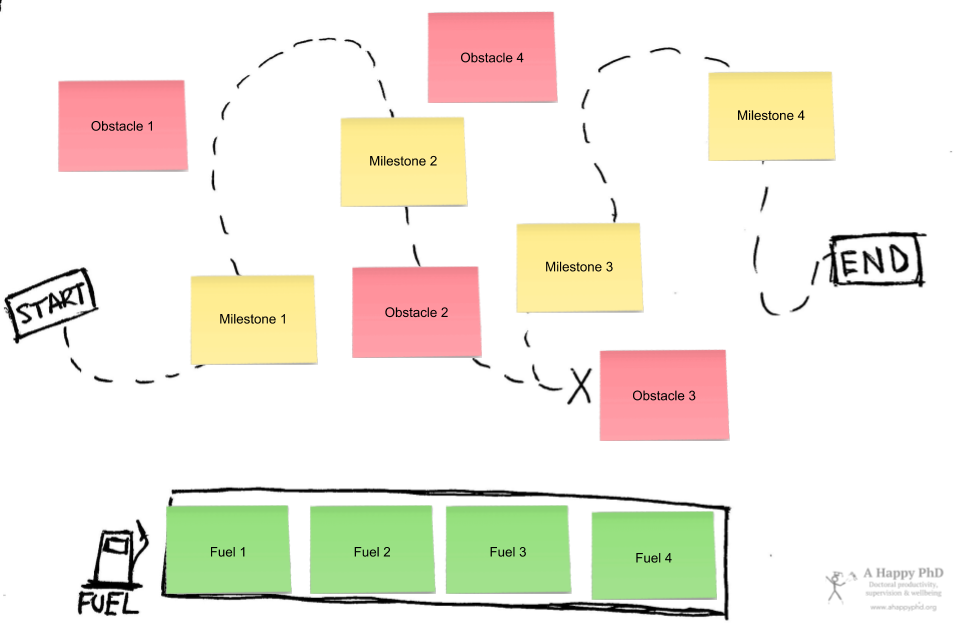POSTS
PhD tool: Map out your PhD
by Luis P. Prieto, - 8 minutes read - 1695 wordsWe know that steady everyday progress is a crucial factor in finishing a PhD. In previous posts, we have seen productivity techniques to support us in taking more of these daily steps. Yet, a lot of walking does not necessarily get us anywhere. We need to know that we are actually getting past key reference points, closer to our final destination. In this post, I propose a diagramming exercise to map out key obstacles, milestones and the “everyday fuel” that propels us past them in our journey towards PhD completion.
The idea for this exercise comes from the doctoral and supervisor workshops about progress that we have been doing since 2019, both in Estonia and in Spain. Despite the big distance (geographic and cultural) between these two countries, we noticed a common pattern. Doctoral supervisors that seemed to be “on top of things” in supporting their students to progress towards completing the PhD, mentioned in passing that they had a clear plan, a “map of the PhD” that they discussed with their students and helped them know how far they were from the destination. This got me thinking: is there a way we can help PhD students make sense and track their progress at a higher level, a sort of “10,000-meter view” of the doctorate?
In a previous post, I have talked about a diagram that helped me (and many other students –now doctors– around my old lab in Spain) to conceptualize, define and refine the main concepts and contributions of the thesis (the CQOCE diagram). Yet, that diagram provides no idea about the process until those contributions come to fruition. And it says absolutely nothing about the biggest risks and pitfalls to watch out for.
Enter the map of the PhD…
Mapping out the PhD… step by step
The map of the PhD will guide us in the long journey through uncertain terrain that is research. Think of it more like a medieval map, rather than a nice, modern map of roads and cities.
A map of this kind has three types of elements: milestones (reference points), obstacles (places to avoid), and fuel stations (inns and villages where we get the energy and nourishment needed to go from one milestone to the next). Below, I illustrate these elements with examples drawn from the workshops, but keep in mind that:
- We need to come up with our own elements, for our own field, research topic and our own personal strengths and weaknesses.
- Even if we brainstorm at the beginning many elements of each kind, it is useful to prioritize and simplify the map so that it contains only the 4-8 most important elements of each kind: the ones we need to focus on the most.
The Milestones
Brainstorm and select what are the most important reference points in the PhD process. These are events or actions that will happen only once or rarely during the doctorate, which are crucial to know that our thesis is going somewhere. Examples could include:
- to write and present the thesis project,
- to complete the literature review of the thesis (including a synthesis of the main gaps detected in it),
- to perform a research/lab process reproducibly,
- presenting our results at a conference,
- designing a study that is considered feasible by the supervisors,
- having your first journal article published,
- having the CQOCE diagram of the thesis be considered final/stable by the supervisors,
- completing a draft of the analytical overview (sometimes called kappa) of an article-based thesis,
- doing a research stay abroad
… or anything else relevant for our particular thesis. The order of these milestones may or may not be important. The milestones should probably have scientific or learning relevance (rather than being bureaucratic in nature, like the yearly attestation process happening in some doctoral programs, where the contributions/content is not really discussed). Also, try to come up with milestones of different kinds (i.e., do not just put “write article 1”, “write article 2”, … etc.).
Here be Dragons (aka The Obstacles)
Again, we can brainstorm and select the most important, concrete obstacles and challenges that might prevent us from finishing the PhD. These can be internal (i.e., related to our particular personality, tendencies, or the nature of our thesis project) or external (i.e., economic or social factors, or unpredictable but probable events that may influence our progress). A nice way of brainstorming these challenges is to do (alone or with a group of fellow students) a "premortem1 of our thesis". Our initial brainstorm can be pared down to the 4-8 challenges that we deem most likely to happen, catastrophic, or difficult for us to overcome. Example obstacles could include:
- Procrastination (internal)
- Too much stress or anxiety (internal)
- Vague or non-existent thesis project (internal)
- Overwork and burnout (internal)
- Poor post-PhD outlook demoralizing us (internal)
- An experiment provides bad results (external)
- Technical problems in running an experiment (external)
- Getting too little (or too much?) guidance/supervision (external)
- Toxic department/laboratory atmosphere (external)
- A global pandemic cancels our research stay (external)
The Fuel
So far, we have been talking about clearly meaningful but infrequent events that either give us a big push forward… or send us down a cliff. Yet, between these milestones months apart, there is the everyday. The PhD is a long-distance race, and such distances are covered one step at a time, day after day, getting up and doing more of the right things and less of the not-so-good stuff.
Following the medieval journey metaphor, I see these everyday actions as the inns at the end of a day’s march, providing a bed and a dinner, which enable us to recover and continue walking the next day. These are much more frequent, often smaller, actions or habits we take on and do every day… or things we put in our “not-to-do list”. Be it through doing or not doing them, they help us avoid the obstacles and make sure we hit the milestones. I’ll say it again, these can be very personal.
People often focus this “fuel” part too much on events that they cannot control. That sort of fuel is a sure recipe for getting stranded in the middle of nowhere. An example could be “get a paper accepted”, as opposed to “submit a paper we are happy with” – the latter being much more under our control. While there can be a certain element of chaos or randomness in getting to milestones, and in the obstacles that pop up on the way, our fuel should be as much as possible under our control (e.g., focusing on our own behavior, rather than other people’s actions or judgements).
Also, make sure that fuel is frequent enough: daily is best for developing habits, but weekly could also work. If we decide to leave a less-frequent fuel piece in the map, we can think of it as a sort of “occasional turbo boost”… we still need most of our fuel to come from more conventional, frequently-available sources.
Example fuel items may include:
- (Feedback during) Regular thesis-oriented meetings with supervisors,
- Discussing our work with external researchers,
- Writing results reports after each study,
- Reading research in our area regularly and writing syntheses/reflections about them,
- Writing new concepts regularly in our lab notebook,
- Solving particular technical problems,
- Learning new lab techniques,
- Writing regularly,
- Teaching others a method we know,
- Taking time off with family/friends regularly,
- Any habits related to exercise, good sleep or nutrition
A few additional notes on the mapping process
That’s it! Now we have all we need to start mapping out our PhD. Do it using pen and paper, or copy this Google Drawings template I created.
Update (23.06.2022): We have now added a “map of the thesis” template you can copy to our PhD Toolkit (under the “Conceptualizing your dissertation” section).
A few more ideas about how I would go about doing it:
- We can do this exercise alone, but it would be even better to do it together with other PhD students in our area/lab/department (that’s what we do in the workshops I mentioned at the outset).
- Every research area (and sub-area, and sub-community) is different. Also, every person is different: we all have different strengths and weaknesses that may play out during the PhD. Hence, even if we do a map together with others, we may want to tweak it for our own particular case later on.
- No matter how good our initial map of the PhD is, it will probably benefit from suggestions and feedback from colleagues and supervisors (especially, more experienced researchers that have seen many doctoral processes in our area). We could show them the whole map, or just ask a few questions about its elements: what is the most common reason you have seen PhD students fail? what habits helped get you through your PhD? what would you say are the most important milestones in a PhD in our field? Etc.
- The map is just another tool to help us reflect about the PhD. I would use it sparingly, maybe just at the beginning of the PhD (or in the first meetings with a new PhD student, if you are a supervisor), or in less-frequent reviews and self-reflections (e.g., once a semester). If we focus on this goal-oriented view too much or too frequently, it runs the risk of making us excessively obsessed with the destination… while the PhD is also a process to enjoy in its own right!
We could take the map metaphor further (what would be the equivalent of alternative routes? or scenic spots? or …), but this is the simplest exercise I could come up with that still provides a complete idea of the dissertation process.
Just do it. See if it helps you decide what to focus on for the next stretch of the way.
Did you try out this exercise? Did you do it alone or with fellow students? Let us know how it went (you can even share links to your resulting maps), in the comments area below!
Header image by Wikimedia Commons
-
Klein, G. (2007). Performing a project premortem. Harvard Business Review, 85(9), 18–19. ↩︎

Luis P. Prieto
Luis P. is a Ramón y Cajal research fellow at the University of Valladolid (Spain), investigating learning technologies, especially learning analytics. He is also an avid learner about doctoral education and supervision, and he's the main author at the A Happy PhD blog.

